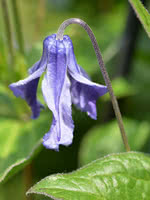Mon-Fri 9am - 5pm Mountain time
Blue Boy Clematis vs Hairy Golden Aster
Heterotheca villosa
Clematis integrifolia Blue Boy
NOT AVAILABLE THIS SEASON - MIGHT RETURN
NOT AVAILABLE THIS SEASON - MIGHT RETURN
Hairy Golden Aster is a native perennial wildflower known for its clusters of bright yellow, daisy-like blooms. They bloom from mid-summer into fall, providing late-season colour and a valuable nectar source for pollinators, including a variety of bee species.
Flowers mature into fluffy seed heads and can self-seed readily. Removing spent blooms helps manage their spread, but some people will choose to leave a few seed heads to provide food for birds. Hairy Golden Aster grow in bushy clumps, tolerates poor sandy soils, and once established, are among the most drought-tolerant wildflowers. They are well-suited for pollinator gardens, restoration, naturalization, and xeriscaping projects.
Blue Boy Clematis is a cold-hardy, fast growing, woody climbing vine. Hundreds of stunning steel-blue bell shaped flowers adorn the vine throughout the summer that droop and appear to hang in the air. The fibrous stems spread and create a fan-like symmetry shape.
This species will do best with support from a trellis, fence, or even other shrubs or tree stumps.
The Blue Boy Clematis was developed in Manitoba, Canada in 1947 by famous breeder Frank L. Skinner by crossing C. integrifolia x C. viticella, but it didn’t gain popularity until the 1990’s.

